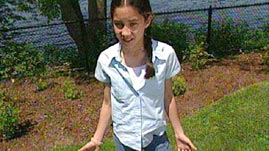Teachers' Domain - Digital Media for the Classroom and Professional Development
User: Preview


Source: ZOOM
In most parts of the United States, getting clean, safe water is as easy as turning on a faucet. Generally, this water comes from either groundwater or nearby streams and reservoirs. What most of us never see or have to worry about are the steps required to make this water drinkable. In this video segment adapted from ZOOM, cast member Noreen finds out how a water treatment facility in Cambridge, Massachusetts purifies its city's water.
Water Treatment Plant (Audio Description) (Video)
Early American settlers took water quality for granted. In lightly settled towns and villages in the 17th and 18th centuries, people found clean drinking water in nearby streams and lakes, as well as in wells they dug to access groundwater. However, as population densities increased in urban centers, many water supplies became contaminated, and people fell ill as a result of drinking the impure water. Between 1831 and 1832, tens of thousands of people died in Europe and the United States from a cholera epidemic, the result of drinking water contaminated with human waste.
Today, in developing countries around the world, disease-causing water-borne microbes and chemical contaminants sicken millions of people each year. For this reason, public health organizations have made sanitation a priority in an effort to provide all people with access to clean, fresh drinking water.
In developed countries such as the United States, government agencies require that the approximately 160,000 water treatment facilities supplying drinking water nationwide meet strict safety and quality standards. The Environmental Protection Agency (EPA) in the U.S. regulates the levels of dozens of potential contaminants, from the bacterium that causes cholera and the virus that causes Hepatitis A to lead, mercury, and arsenic. In most cases, the only allowable level of these contaminants is zero. Some chemicals, such as Chlorite, a by-product of some purification processes, are tolerated at low levels.
Public drinking water generally comes to a treatment facility either from underground aquifers or from surface streams and reservoirs such as the one featured in this video segment. Depending on the quality of the incoming raw water, treatment facilities use a variety of processes to make the water safe enough to drink. At the facility in Cambridge, Massachusetts, workers first add alum to the water. This chemical coagulates suspended particles, algae, protozoa, viruses, bacteria, and manganese into larger particles that float to the top as a "sludge" that can be skimmed off the surface. Facility workers then bubble ozone through the water to kill remaining bacteria, viruses, and protozoa. Next, they use activated carbon filters to remove organic compounds and any particles still in the water. Chlorine is then added to kill any bacteria that may have entered the water during the filtration process. The final step involves adjusting the water's pH level to limit corrosion in the public water system and, in some communities, adding fluoride to help fight tooth decay in the population.
 Loading Standards
Loading Standards Teachers' Domain is proud to be a Pathways portal to the National Science Digital Library.
Teachers' Domain is proud to be a Pathways portal to the National Science Digital Library.
